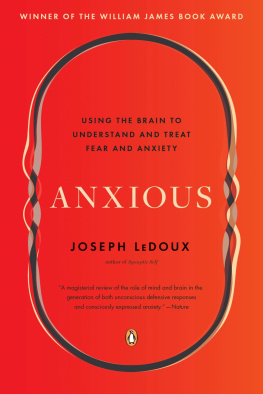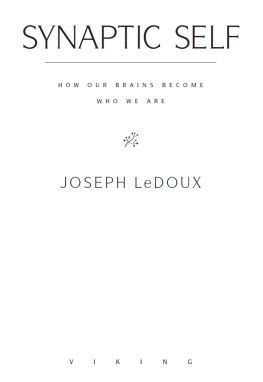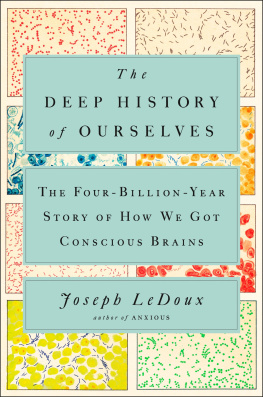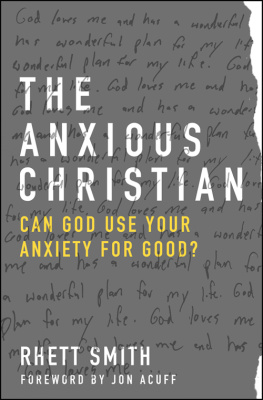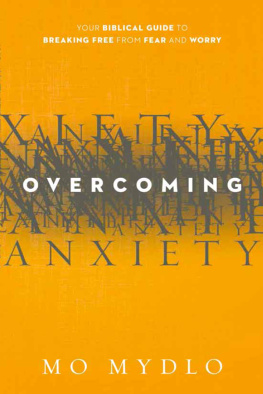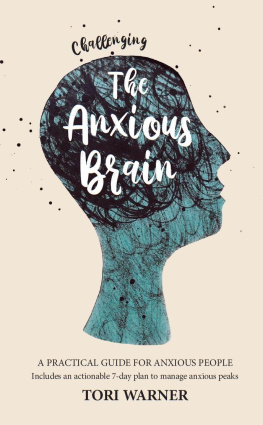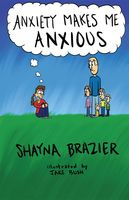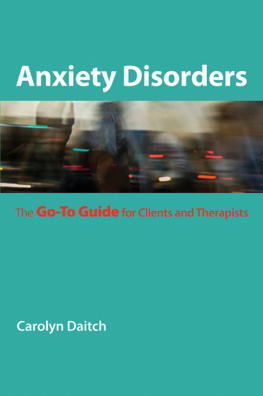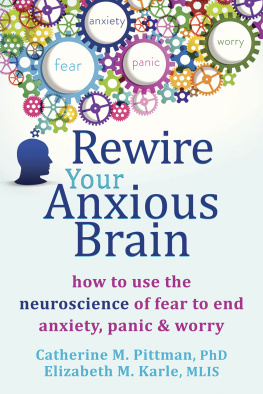First published in the United States of America by Viking Penguin, an imprint of Penguin Random House LLC, 2015
Penguin supports copyright. Copyright fuels creativity, encourages diverse voices, promotes free speech, and creates a vibrant culture. Thank you for buying an authorized edition of this book and for complying with copyright laws by not reproducing, scanning, or distributing any part of it in any form without permission. You are supporting writers and allowing Penguin to continue to publish books for every reader.
Illustration credits appear .
Unless otherwise cited, illustrations by Robert Lee, copyright 2015 by Joseph LeDoux
To all the researchers who have worked with me over the years and to all my colleagues who have helped move our understanding of fear and anxiety forward
PREFACE
W hen I completed my previous book, Synaptic Self, which was published in 2002, I wasnt certain I wanted to write another book for a general audience. I had gotten the idea that the way to really have an impact on the field was to write a textbook in my particular area, behavioral and cognitive neuroscience. My agents, John Brockman and Katinka Matson, urged me not to, as did my editor at Viking, Rick Kot, each of them warning me that I would regret it as a publishing experience. After struggling with the project for almost a decade, I had to admit that they were correct. I discovered that the textbook format was far too restrictiveit had to be fresh and innovative... so long as it was just like every other competing book. After each chapter was reviewed by a number of teachers from a mix of universities, colleges, and junior colleges around the country, I began to feel little connection to the edited text that was resulting and concluded that my role was more to be a name on the cover than to actually drive the content.
A few years ago I ran into Rick at a reading by our friend Rosanne Cash, who wrote Composed under his editorship, and he asked with a wry smile, Hows that textbook going? Ive been waiting for you to bail out of that and do another book with me. I was thrilled that he was still interested in working with me, and I negotiated, with some help from Eric Rayman, my way out of the textbook and prepared a new proposal for Katinka. Anxious was the result. Rick loved the idea, and so here we are.
Anxious is different from my other books. While The Emotional Brain and Synaptic Self can be thought of as a series of connected essays that hang together around a single theme, in Anxious each successive chapter builds on the previous ones to argue for a new view of emotion, especially the emotions fear and anxiety. Although the book is called Anxious, fear and anxiety are complexly entwined, and must be understood both separately and together.
As an overview, here are the key points that Anxious addresses. First, the science of emotion, and especially the science of fear and anxiety, now finds itself at an impasse, dictated by the way we discuss emotions in relation to the brain. For example, researchers use words like fear to describe the brain mechanisms that cause rats to freeze when in danger, and also to describe the conscious feeling that humans experience if they think that they will be seriously harmed physically or psychologically. The general idea is that a fear circuit in the brain is responsible for the feeling of fear, and when it is activated, whether in a rat or a human, the feeling of fear occurs, along with responses characteristic of fear (such as freezing, facial expressions, changes in body physiology). The feeling of fear is often said to mediate between the threatening event and those responses. Because these circuits are conserved throughout mammals, including humans, we can study human fear by measuring freezing in rats. The key circuits crucially involve the amygdala, which is generally described as the seat of fear in the brain.
In fact, most of what I have just described is wrong. Because my work and writings are in part responsible for these misconceptions, I feel some responsibility to try to straighten out the story before it goes further off track. One of the main goals of this book is to provide a new view of fear and anxiety, one that more accurately distinguishes what we can learn from animals from what we can best learn from humans, and what fear itself really refers to in the context of the human brain.
Dont get me wrong: I am not arguing that we have to study brain mechanisms related to emotions exclusively in humans. There is much we have learned, and can continue to learn, and can, in fact, only learn, from animal research. But we do need a rigorous conceptual framework for understanding what the animal work does and does not mean for understanding the human brain. I offer my view of such a framework, which I think provides a new perspective on fear and anxiety, and the disorders related to these states.
The suggestions I make in this book concern in part the words we use to describe certain phenomena, but my argument is not simply about semantics. Words have extended meanings that imply a great deal. For example, some researchers who study fear in rats by measuring freezing behavior say that they are not studying what most people think of as fear, but rather some nonsubjective physiological state that they call fear. While this scientific redefinition of fear makes it more tractable as a research problem, it has three disadvantages. First, using fear in a nonconventional way to describe a physiological state that connects threats with responses often leads researchers to write and talk about this state as if it was referring to the conscious feeling of fear. Second, even when the researchers adhere to that definition, everyone thinks that they are actually studying the feeling of fear. And third, we in fact do need to understand the feeling of fear, and ignoring it is not the solution.
As scientists we have an obligation to be precise in how we describe our research. This is especially important when the work is being used to conceptualize human problemsin this case, fear and anxiety disordersand develop treatments for them. But because conscious feelings of fear and anxiety arise from circuits in the brain that differ from the circuits that control the expression of defensive behaviors like freezing, and are likely vulnerable to different factors, they need to be understood separately. Certainly the circuits that control defense responses and give rise to feelings of fear interact, but this does not mean that they are the same.
Failure to make such distinctions accounts for poor outcomes of studies that have attempted to develop new pharmacological treatments for fear and anxiety in animals, as the studies assess the effects of drugs on behavioral responses but then expect the drugs to actually make people feel less fearful or anxious. We have long known that there is discordance in how treatments affect the way people feel when threatened as opposed to the behavioral and physiological responses they express in such situations.

